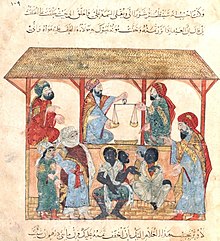Yahya ibn Mahmud al-Wasiti
Yahya ibn Mahmud al-Wasiti (Arabic: يحيى بن محمود الواسطي) was a 13th-century Iraqi-Arab[1][2][3] painter and calligrapher, noted for his illustrations of al-Hariri's Maqamat.
Biography[]
Al-Wasiti was probably born in Wasit واسط south of Baghdad.[4] In 1237 he transcribed and illustrated a copy of al-Hariri's Maqamat typically shortened to Maqamat, and also known as the Assemblies,[5] a series of anecdotes of social satire written by Al-Hariri of Basra. Al-Wasiti's illustrations, which are among the finest examples of a style used in the 13th-century, served as an inspiration for the modern Baghdad art movement in the 20th-century.[6]
Very little is known about his life. He was from the 13th century school of painting. He was known for his articulate painting style.[7]
Illustrations from Maqamat[]
In total, Maqmat has 96 illustrations, all by al-Wasiti. They are of "outstanding quality with fine composition, expressive figures, and vivid but controlled colours" and provide readers with "fascinating series of glimpses into and commentaries on 13th-century Islāmic life."[8]
See also[]
References[]
- ^ Makiya, Kanan (1991). The Monument: Art, Vulgarity, and Responsibility in Iraq. University of California Press. p. 92. ISBN 9780520073760.
Arab painter al wasiti.
- ^ Ankori, Gannit (2013). Palestinian Art. Reaktion Books. ISBN 9781780232416.
- ^ Explorers: Tales of Endurance and Exploration. Penguin. 2010. ISBN 9780756675110.
- ^ Jonathan Bloom and Sheila S. Blair (eds), Grove Encyclopedia of Islamic Art & Architecture, Oxford University Press, 2009, p.210; Kember, P. (ed.), Benezit Dictionary of Asian Artists, Oxford University Press, 2012, ISBN 9780199923014
- ^ Jonathan Bloom and Sheila S. Blair (eds), Grove Encyclopedia of Islamic Art & Architecture, Oxford University Press, 2009, p.294
- ^ Wijdan, A. (ed.), Contemporary Art From The Islamic World, p.166
- ^ "Yaḥyā ibn Maḥmūd al-Wāsiṭī," in: Encyclopædia Britannica, Online:
- ^ "Yaḥyā ibn Maḥmūd al-Wāsiṭī," in: Encyclopædia Britannica, Online:
| Wikimedia Commons has media related to Yahyâ ibn Mahmûd al-Wâsitî. |
- 13th-century Arabs
- 13th-century people of the Abbasid Caliphate
- Arab artists
- Muslim artists
- Manuscript illuminators
- Iraqi calligraphers
- Iraqi painters










